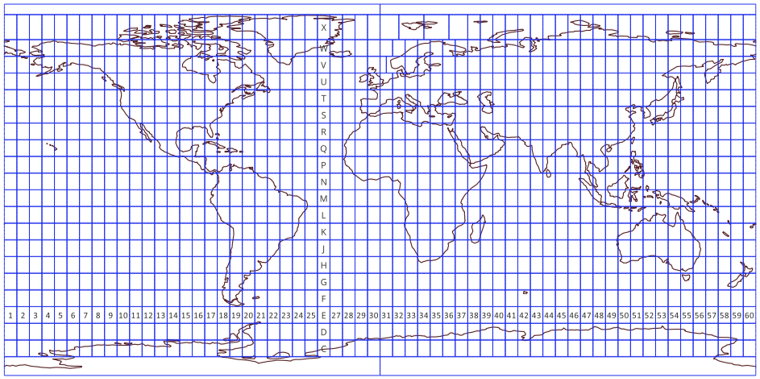F. Universal Transverse Mercator System
1. General
The Universal Transverse Mercator (UTM ) System is collection of 60 adjacent cylindric map projections circumventing the earth. It was adopted in 1947 by the US Army for world-wide military map creation. Each projection, or zone, is 6° wide and runs from 80° S latitude to 84° N latitude (the Poles are covered by plane projections).
Zones are numbered 1 to 60 from west to east, Figure F-1. Each zone is divided into 20 blocks lettered C to X from south to north.
 |
| Figure F-1 UTM Zones |
Table F-1 shows the zones pattern: ID, longitude span, and CM longitude.
| Table F-1 UTM Zones |
||
| Zone |
Span |
CM |
| 1 | 180°W-174°W | 177°W |
| 2 | 174°W-168°W | 171°W |
| ... | ||
| 30 | 6°W-0° | 3°W |
| 31 | 0°-6°E | 3°E |
| ... | ||
| 59 | 164°E-174°E | 171°E |
| 60 | 174°E-180°E | 177°E |
2. Projection parameters
Each zone is identical, just rotated 6° from its abutting neighbors.
| Table F-2 Zone Parameters |
||
| λCM | CM longitude | varies; see Table F-1 |
| SCM | Scale along CM | 0.9996 |
| φo | Origin latitude | 00°00'00 (equator) |
| λo | Origin longitude | varies; see Table F-1 |
| Xo | False Easting | 500,000 m |
| Yo | False Northing | N hemisphere: 0 m S hemisphere: 10,000,000 m |
Although zones are divided into 20 blocks, a point location is uniquely expressed as (X,Y) and Zone number with either a N (north hemisphere) or S (south) suffix.
3. Distortion
The 0.9996 scale at the CM is a distance distortion of 1/2500 (ellipsoid to grid). The scale and 6° width allows for a certain degree of overlap between zones. A 1/2500 distortion is sufficient for small(er) scale mapping but generally too large for most surveying applications.
4. Software
NGS Coordinate Conversion and Transformation Tool (NCAT) is an online package for performing coordinate conversion, and computes convergence and grid scale factor. Input and output can be interactive or file-based.
There's also a simple NAD 83 Coordinate Conversion Excel workbook I put together. It includes all the SPC zones (except Alaska) and UTM zones which cover the US. The workbook is handy If you're interested in the mathematics of conversions. Click here to download it.